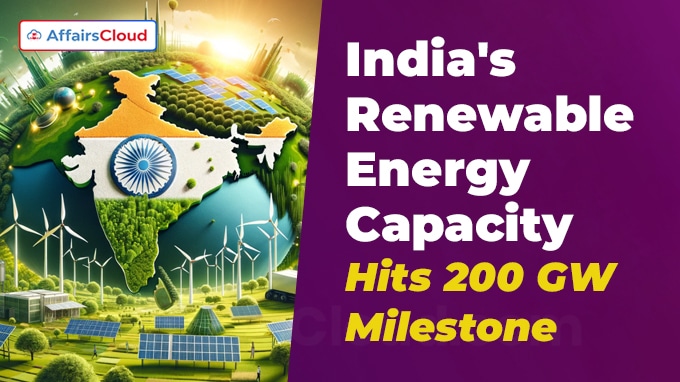 According to the Central Electricity Authority (CEA)’s data, India’s total renewable energy-based electricity generation capacity has increased by 24.2 GigaWatt (GW) (13.5%) to 203.18 GW in October 2024 compared to 178.98 GW in October 2023.
According to the Central Electricity Authority (CEA)’s data, India’s total renewable energy-based electricity generation capacity has increased by 24.2 GigaWatt (GW) (13.5%) to 203.18 GW in October 2024 compared to 178.98 GW in October 2023.
- This remarkable growth in Renewable Energy (RE) is in line with the country’s ambitious RE target of achieving 500 GW from non-fossil sources by 2030.
- Also, when including nuclear energy, India’s total non-fossil fuel capacity has increased from 186.46 GW (in 2023) to 211.36 GW (in 2024).
Key Facts :
i.At present, India’s total electricity generation capacity has reached 452.69 GW, with RE contributing a major portion of the overall power mix.
ii.As of October 2024, RE-based electricity generation has surpassed the mark of 200 GW, accounting for over 46.3% of the country’s total installed capacity.
iii.Solar Power saw an increase of 27.9%, from 72.02 GW (in October 2023) to 92.12 GW (in October 2024) and has emerged as the largest contributor to RE-based power generation in 2024, followed by Wind power (47.72 GW) with Year-over-Year(Y-o-Y) increase of 7.7%.
- Other key contributors like Hydroelectric power with large hydro projects generating 46.93 GW and small hydro power contributing 5.07 GW; and Biopower which includes both biomass and biogas energy, has contributed a total 11.32 GW to the RE mix.
iv.As on 13th November 2024, Rajasthan topped among the states in RE capacity with an impressive 29.98GW of installed RE capacity, followed by Gujarat (29.52 GW), Tamil Nadu (TN) (23.70 GW) and Karnataka (22.37 GW) ranked at 2nd, 3rd and 4th position respectively.
Surge in Job Opportunities in RE Sector:
i.According to International Renewable Energy Agency’s (IRENA) 2024 Annual Review, India’s RE sector achieved a significant milestone with an estimated 1.02 million jobs generated in 2023.
- The report was prepared by IRENA in partnership with the International Labour Organisation (ILO).
ii.The report further revealed that the global RE workforce increased from 13.7 million (in 2022) to 16.2 million (in 2023), with India playing a crucial role in this growth.
iii.As per the report, Hydropower emerged as the largest employer in the RE sector in India in 2023, providing nearly 4.53 lakh jobs, which accounted for 20% of the global total jobs in RE, second only to China.
iv.The Solar Photovoltaic (PV) in India has employed approximately 3.18 lakh people across both on-grid and off-grid systems, of which 2.38 lakh people were employed in grid-connected solar PV(showing an increase of 18% compared to 2022) while around 80,000 people were employed in the off-grid solar sector.
- India added 9.7 GW of Solar PV capacity in 2023 and ranked at 5th position globally in terms of new installations and total capacity, which reached 72.7 GW by the end of the year.
- India’s operational module manufacturing capacity reached 46 GW in 2023, estimated to grow to 58 GW in 2024.
- Similarly, cell manufacturing capacity was 26 GW in 2023 and is expected to reach 32 GW in 2024, thus making India the world’s 2nd largest PV manufacturer after China.
v.The wind sector in India employed nearly 52,000 people in 2023, with around 40% in operations and maintenance and 35% in construction and installation.
vi.Other RE subsectors also contributed to job creation like: liquid biofuels (35,000 jobs), solid biomass (58,000 jobs), and biogas (85,000 jobs).
- Also, the solar heating and cooling sector employed 17,000 people, reflecting the diverse and expanding job opportunities within India’s RE industry.
Note: Abu Dhabi, the United Arab Emirates(UAE) based IRENA was founded in 2009.
India’s Global Commitments Related to RE Sector:
i.As part of the updated Nationally Determined Contributions (NDCs) submitted by India to the United Nations Framework Convention on Climate Change (UNFCCC) in August 2022, India has pledged to reducing emissions intensity by 45% by 2030 (compared to 2005 levels), achieving 50% of cumulative electric power capacity from non-fossil fuel sources by 2030 and promoting a sustainable way of life through the “Lifestyle for Environment (LIFE)” movement.
ii.These targets will also help India to achieve its long-term goal of reaching Net-Zero emissions by 2070, supported by the “Long-term Low Carbon Development Strategy” submitted to the UNFCCC in November 2022.
iii.Over the last few years, the Government of India (GoI) had launched various initiatives and schemes to promote RE sector in India like National Green Hydrogen Mission, Pradhan Mantri Kisan Urja Suraksha Evam Utthaan Mahabhiyaan (PM-KUSUM),Pradhan Mantri (PM)-Surya Ghar: Mufti Bijli Yojana and the Production Linked Incentive (PLI) schemes for solar Photovoltaic (PV)modules, among others.
About Central Electricity Authority (CEA):
It is a statutory body established under section 3(1) of the Electricity Supply Act, 1948, now superseded by section 70 (1) of the Electricity Act 2003. It is administered by the Ministry of Power (MoP).
Chairman- Ghanshyam Prasad
Headquarters- New Delhi, Delhi




